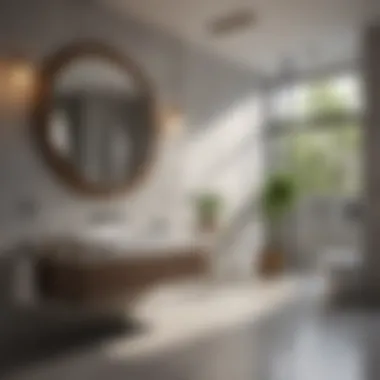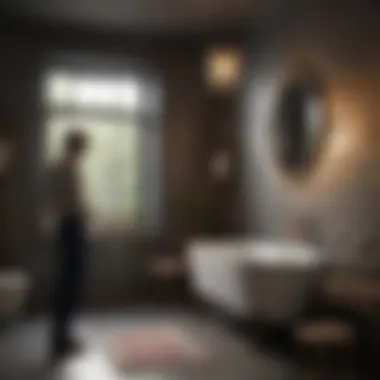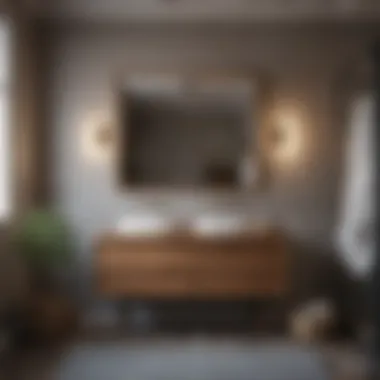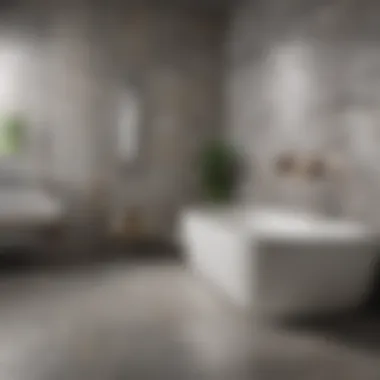Finding Local Bathroom Designers: A Practical Guide


Intro
The quest for a well-designed bathroom can often feel overwhelming. As homeowners, the decision to remodel this critical space is significant. One of the most important aspects to consider in this journey is finding the right local bathroom designer. Local expertise can influence the outcome of your project profoundly. Whether you want to create a spa-like retreat or a functional space for the family, understanding the process and recognizing key factors leads to a successful renovation.
In this guide, we will explore how to navigate the multitude of options available to you. We will examine current design trends, innovative ideas, and best practices for evaluating potential designers. The goal is to help you make informed decisions tailored to your specific needs. Let us embark on this journey to transform your bathroom into a space that is both stylish and functional.
Understanding the Role of Bathroom Designers
When considering a bathroom renovation, the role of bathroom designers cannot be understated. They serve as the bridge between your vision and the practical elements needed to bring that vision to life. Understanding this role is critical not only for selecting the right designer but also for ensuring that your design project runs smoothly and achieves the desired outcome.
Defining Bathroom Design
Bathroom design encapsulates the concept of planning and organizing the layout, aesthetics, and functionality of a bathroom space. This involves a thorough analysis of the existing space and understanding how to optimize it for usage. A bathroom designer focuses on several key aspects, including:
- Layout: Determining the most effective arrangement of fixtures and fittings to maximize space.
- Aesthetics: Selecting colors, materials, and styles that reflect your personal taste yet conform to broader design trends.
- Functionality: Ensuring that the bathroom serves its intended purpose, is comfortable, and meets the needs of all users.
Ultimately, bathroom design marries form and function, creating a space that is both beautiful and efficient.
The Importance of Design Expertise
Expertise in bathroom design is a vital asset in avoiding common pitfalls that arise during renovation projects. A seasoned designer brings a wealth of knowledge that can help you save time and money. This expertise includes understanding local building codes, leveraging relationships with suppliers, and identifying potential issues early in the process.
Some reasons why design expertise is invaluable include:
- Problem-Solving: Experienced designers can anticipate challenges that might not be evident to homeowners, providing feasible solutions without excessive costs.
- Creative Solutions: A skilled designer can propose innovative ideas that align with your goals while enhancing both beauty and utility.
- Resourcefulness: With a designer's knowledge of local market trends, you can take advantage of materials and services that may not be cataloged online.
Why Local Designers Matter
Choosing a bathroom designer is a critical step for homeowners aiming to refine their space. The significance of local designers cannot be overstated. They offer advantages that extend beyond aesthetic appeal; they imbue projects with a deep understanding of regional idiosyncrasies. With local expertise, these designers can reflect the community's values and styles in their work. This ultimately ensures that you get a bathroom that fits not only your needs but also the local context.
Another important element is the feasibility of logistics. Local designers have immediate access to suppliers, skilled labor, and resources that non-local professionals might find challenging to manage from a distance. Quick access to materials and labor can reduce waiting times. This means that renovations can progress without unnecessary delays, aligning with your project timeline.
"Working with local designers means home improvement projects can flexibly adapt to the ever-changing demands of the local neighborhood."
Understanding Local Trends and Styles
The ability to comprehend local trends and styles is a distinct advantage that local designers bring. Design preferences often emerge from cultural influences, climate, and community lifestyles. These factors shape popular styles, colors, and materials used in bathroom design. For example, a coastal region might favor light colors and natural textures, while an urban setting may embrace modern, sleek finishes.
Working with someone who understands these trends allows homeowners to tap into a design that adds value to their property. Besides, it creates a coherent look that resonates with the broader aesthetic of the neighborhood, making your bathroom not just a personal space but also a seamless part of your home's overall design.
Access to Local Resources and Materials
Local designers have the distinct advantage of connecting with regional suppliers. Knowledge of where to source specific materials is essential. They can often procure items like tiles, fixtures, and fittings more efficiently. This direct access can lead to cost savings. Local sourcing also means you can often find unique items not available through larger, national chains.
Moreover, understanding the local market can help in making informed decisions about what is worth investing in. Designers may know which brands offer the best quality for your area or which local artisans create unique products. This localized knowledge ultimately enriches your project and allows for personalization that reflects your tastes and values.
In summary, engaging a local bathroom designer offers crucial benefits by aligning projects with local trends, ensuring easy access to resources, and promoting efficiency. Their expertise translates into a bathroom that not only meets your needs but also integrates beautifully into the local environment.
Preliminary Research: How to Start
Before diving into the world of bathroom design, it is crucial to undertake thorough preliminary research. This foundational step allows homeowners to define their vision, gather ideas, and establish a clear path for progression. Understanding your own needs and preferences lays the groundwork for effective communication with designers later on. It can also save time and money, ensuring that your chosen designer aligns with your expectations from the outset.
Defining Your Needs and Preferences


Defining your needs and preferences is the first step in your research process. Begin by considering the layout and functionality you require. Ask yourself questions such as:
- How many people will use the bathroom?
- What features are essential? For instance, a shower, bathtub, or storage space.
- What is the intended style? Contemporary, traditional, or a mix?
Taking the time to clarify these requirements helps in forming a strong basis for collaboration with designers.
Utilizing Online Resources
The internet is a powerful ally when beginning research into bathroom design. Several platforms can provide valuable insights and help streamline your decision-making process.
Home improvement websites
Home improvement websites are often treasure troves of information. They feature a vast array of design ideas, trends, and renovation tips. A key characteristic of these sites is their extensive galleries. Users can browse through countless images showcasing different styles and layouts. This visual representation is beneficial because it inspires creativity and allows homeowners to visualize their own space.
However, a disadvantage of home improvement websites is the overwhelming amount of information. It can be easy to get lost in the myriad of choices. Thus, it is important to maintain focus on your specific goals as you explore.
Social media platforms
Social media platforms have become essential for discovering trends and gathering design ideas. Platforms like Instagram and Pinterest are particularly popular among homeowners. Their visual nature allows easy sharing of design inspiration.
A key attribute of social media is community engagement. You can ask questions, seek advice, or request feedback from others who have recently undergone similar projects. This accessibility makes it a beneficial tool. Yet, there is a drawback; the information may not always be reliable or vetted. It is essential to consider the source before making decisions based on social media findings.
Local business directories
Local business directories provide an effective means of finding bathroom designers in your area. Unlike broader platforms, these directories focus on professionals in specific regions. This focus helps you connect with local talent who understand regional trends, materials, and regulations.
A unique feature of local business directories is user reviews. Reading about other clients’ experiences can inform your choices and offer a glimpse into how the designer interacts with clients and addresses their needs. On the downside, the number of reviews can vary greatly. A designer with few reviews may not provide a complete picture of their capability.
Utilizing these various online resources equips you with a wealth of information and ideas needed to effectively engage with potential designers. The goal is to develop a confident understanding of your project needs, enabling productive discussions as you move forward.
Creating a Shortlist of Designers
Creating a shortlist of designers is a crucial step in the process of finding the right professional for your bathroom renovation. Investing time and effort into this phase can help you identify candidates who are not only qualified but also align with your specific needs and aesthetic preferences. A well-curated list allows you to conduct more focused evaluations of each designer's capabilities, experience, and suitability for your project. This can ultimately save resources and minimize potential frustration as you navigate the complexities of bathroom design.
Referrals and Recommendations
Harnessing referrals and recommendations can be one of the most effective ways to compile your shortlist. Start by asking friends, family, or neighbors who have recently undergone renovations. Their firsthand encounters can provide insights into the designer's strengths and weaknesses. Additionally, consider reaching out to other professionals in the construction or home improvement industries. Plumbers, electricians, and contractors often have established connections with designers and can point you in the right direction.
Utilizing community platforms and social media like Facebook groups can also yield valuable suggestions. These platforms often host discussions on local services and experiences, giving you a broader perspective. Local homeowner associations may have directories or forums where recommendations can be sought out. Keep in mind that the most effective referrals often come with personal anecdotes, allowing you to gauge not only the designers' technical knowledge but also their interpersonal skills and reliability.
Evaluating Online Reviews
Once you have gathered referrals, the next step is to delve into online reviews. Websites such as Yelp or Houzz can be invaluable for exploring customer feedback about potential designers. Pay close attention to the overall rating, as well as the volume of reviews. A low rating based on a few experiences may not carry the same weight as a solid rating derived from many projects.
Read through individual reviews to understand the specifics of previous projects. Are customers satisfied with the design process? How well did the designer communicate? Was the project completed on time and within budget?
While positive reviews can indicate competence, negative reviews can be equally enlightening. They are often more telling about a designer's weaknesses and may prevent future disappointment. Look for patterns in the feedback, as these can highlight consistent strengths or issues for a designer.
Additionally, engaging with reviewers can be beneficial. Some platforms allow you to ask questions about the designer's work and overall experience. This interaction can provide further clarity and help you make more informed decisions.
"Referrals and online reviews are powerful tools that can help navigate the often overwhelming process of selecting a bathroom designer."
By approaching the creation of your shortlist with a methodical mindset focused on referrals and thorough evaluation of reviews, you position yourself to select a designer who not only meets your needs but can also bring your bathroom vision to life.
Questions to Ask Potential Designers


When embarking on the journey to enhance your bathroom with professional design support, understanding what to ask potential designers is crucial. This section focuses on the significance of asking the right questions. It allows you to assess designers thoroughly, ensuring their expertise aligns with your vision and project needs. Choosing the right designer can impact the final look and functionality of your bathroom.
Assessing Qualifications and Experience
Evaluating the qualifications and experience of your potential designers is a foundational step in the decision-making process. Consider asking about their educational background. Have they completed courses or obtained certifications in interior design, particularly in bathroom design? Some relevant certifications may include those from the National Kitchen & Bath Association (NKBA) or similar organizations.
Next, inquire about their work history. Ask for examples of past projects, especially those resembling your style or requirements. It’s beneficial to see their portfolio, which can reveal the designer's creative capabilities and attention to detail. Pay attention to whether they have experience working with diverse materials and styles, as this flexibility is often key to unique bathroom design.
"Evaluating a designer’s past work can provide insights into their style, skill level, and how well they might understand your needs."
Moreover, it is wise to ask for references. Speaking with former clients can deliver real insight into their working relationship and the outcome of previous projects. Learn about their level of satisfaction and whether the designer was able to adhere to budget and timelines.
Understanding Their Design Process
Equally important is understanding the designer's approach to the design process. This determines how well they can collaborate with you on your project. Start by asking about their typical workflow. Do they begin with a consultation, and what does that entail? Understanding how a designer initiates a project can clarify their methodology.
Additionally, inquire about how they gather your preferences. Do they utilize visual aids like mood boards or catalogs to aid in understanding your vision? This step can significantly enhance the collaboration process and outcomes.
Next, discuss their design revisions process. When changes are necessary, how does the designer accommodate them? Knowing how flexible they are with modifications can affect the project flow.
Finally, it’s vital to understand how they will maintain communication throughout the project. Clear lines of communication can prevent misunderstandings and ensure you are consistently informed about your project’s progress.
By focusing on these questions, you gain a better understanding of how a potential designer operates and whether their style aligns with your expectations. This diligence can significantly enhance the likelihood of achieving a bathroom that meets both your aesthetic desires and functional needs.
Evaluating Project Costs
When embarking on a bathroom renovation, understanding project costs becomes essential. Cost evaluation does not merely represent a financial aspect; it encompasses strategic planning that can ultimately dictate the success of your design endeavor. Homeowners often delve into renovations but might overlook the intricate balancing act between budget constraints and design aspirations. This section outlines how to navigate this complexity while ensuring clarity and control throughout the renovation process.
Establishing a Budget
Setting a realistic budget is one of the first steps you should take. It lays the foundation for what can be achieved and curtails the risk of overspending. Start by considering your overall financial situation and what you can afford without compromising your savings or financial health. It's advisable to allocate funds not just for materials and labor but also for contingencies. Things don’t always go as planned. Unforeseen issues may arise during renovations, prompting you to adjust your budget on the fly.
Additionally, think about your bathroom’s scope. A complete overhaul will naturally demand a larger budget than a simple cosmetic update. Break down your budget into categories such as plumbing, fixtures, tiles, and labor. This will help you visualize where your money will go and allow for adjustments depending on priorities. When planning, aim for a balanced approach:
- Materials Cost: What types of tiles or fixtures do you desire?
- Labor Cost: How many hours of workmanship are needed?
- Contingency Fund: Setting aside a percentage for unexpected expenses.
Understanding Quotes and Estimates
As you commence dialogue with potential designers, you will likely receive various quotes and estimates. Understanding these is critical to making informed decisions. A quote is a fixed price proposal, while an estimate is a rough approximation of costs based on a designer's experience and view of the project. Both serve a purpose but require careful consideration.
First, ensure that each quote or estimate includes detailed descriptions of materials, labor costs, and timelines. It’s important to compare apples to apples. Some designers might provide quotes that appear lower, but lack high-quality materials or necessary labor hours. Seek transparency and ask for breakdowns that clarify costs involved.
Additionally, don’t hesitate to ask questions. Understanding how designers establish their prices can give you insights into their expertise and the value of their service.
"A transparent cost breakdown helps pave the way for a better understanding between homeowner and designer."
Communicating with Designers
Effective communication is paramount when working with bathroom designers. This process not only helps in aligning your vision with the designer’s expertise but also ensures that both parties are on the same page throughout the project. When you communicate well, it can lead to fewer misunderstandings and a smoother design process.
The significance of open dialogue cannot be overstated. It allows homeowners to express their preferences, concerns, and expectations clearly. This clarity helps designers create a space that truly reflects the homeowner's needs while adhering to practical aspects such as budget and timelines. Moreover, strong communication fosters a collaborative atmosphere, contributing to innovative design solutions that might not have emerged in a less communicative environment.
Setting Clear Expectations


One of the foundational aspects of effective communication is setting clear expectations from the beginning. Both parties should be aware of the project scope, timelines, and ultimate goals. Discussing these elements in detail lays the groundwork for a successful collaboration.
Homeowners should articulate what they want in their bathroom, including style preferences, functionality, and budget constraints. Equally, designers should be forthright about their capabilities, processes, and any potential challenges they foresee. By addressing these items upfront, you minimize the chances of disappointment later on.
- Outline project deliverables: Specify what the homeowner can expect at each phase of the project.
- Discuss timelines: Establish realistic schedules that account for unexpected delays, so both parties have a clear understanding.
- Agree on budgets: Clearly define the financial limits to avoid overspending and misunderstandings.
Maintaining Open Lines of Communication
Once the project is underway, it is vital to maintain open lines of communication. Regular check-ins and updates can significantly enhance the relationship between the homeowner and the designer. This not only keeps everyone informed but also allows for quick adjustments if required.
Here are some effective strategies to ensure that communication remains strong throughout:
- Use technology wisely: Tools like emails, project management apps, or group chats can facilitate easy and quick communication.
- Schedule regular meetings: Whether weekly or bi-weekly, having set times to discuss progress can help prevent issues from escalating.
- Be approachable: Homeowners should feel comfortable raising concerns or asking questions, while designers must encourage inquiries to clarify their plans.
Remember, effective communication is an ongoing process, not a one-time task.
By focusing on setting clear expectations and maintaining open communication, homeowners can foster a more productive relationship with their bathroom designers, ultimately resulting in a well-executed project.
The Importance of a Contract
When hiring a bathroom designer, the contract is a critical element that should not be overlooked. A well-defined contract serves multiple purposes, protecting both the homeowner and the designer throughout the renovation process. It outlines the expectations, responsibilities, and scope of work to ensure that all parties are on the same page. Understanding the importance of a contract can prevent misunderstandings, reduce disputes, and provide a reference point for evaluating the project as it progresses.
Furthermore, having a contract in place formalizes the business relationship. It establishes trust and consistency, as both parties have agreed upon the terms legally. The contract also acts as a key tool for accountability, making it easier to hold the designer to their commitments.
"A clear contract is the foundation for a successful project. It communicates the specifics without ambiguity, allowing everyone to focus on the creative aspects of the design."
Key Elements of a Bathroom Design Contract
Several essential elements comprise a solid bathroom design contract. Here are the key components:
- Scope of Work: This section details the tasks that the designer will complete, including design concepts, selections of materials, and installation processes. Clear definitions prevent scope creep.
- Timeline: The agreement should include a project schedule that outlines milestones for project completion. Setting deadlines helps keep the project on track.
- Payment Terms: This includes the total cost of the project, payment schedule, and acceptable forms of payment. Transparency in costs helps avoid financial disputes.
- Change Orders: A clear process for making changes to the original design should be stated. This section allows for modifications but ensures both parties agree to any extra costs.
- Termination Clause: This part specifies the conditions under which either party can terminate the contract, ensuring all parties have a way out under particular circumstances.
Inclusion of these elements can significantly enhance clarity in the working relationship and serve as a reference for all parties involved.
Understanding Terms and Conditions
The terms and conditions of a bathroom design contract are crucial as they define the legal framework within which the project will operate. Homeowners should take time to thoroughly read and comprehend the terms. Here are some key considerations:
- Liabilities and Responsibilities: Understand who is responsible for various aspects of the project, including labor, materials, and any potential errors in construction. This protects the homeowner from unforeseen issues.
- Confidentiality: If sensitive information is shared, the contract should include a confidentiality clause to protect that information from being disclosed without permission.
- Warranties and Guarantees: Check if the designer provides warranties on their work. This assures homeowners that any defects will be repaired without additional costs.
- Dispute Resolution: This outlines the method for resolving conflicts, whether through mediation or arbitration. Knowing how disputes are handled can save time and resources should issues arise.
By understanding the terms and conditions in a contract, homeowners can enter into a renovation project with greater confidence and security.
Post-Project Considerations
After completing your bathroom renovation project, there are essential steps to consider. These post-project considerations can streamline the transition from construction phase to enjoying your new space. They also ensure the longevity of your renovations and maintain the overall quality of the work.
Evaluating the Completed Work
Once the project is complete, take time to thoroughly evaluate the finished work. This step is critical to confirm if everything aligns with your expectations and the original design plans.
- Check for Flaws: Examine surfaces, fixtures, and finishes for any imperfections or defects. Look for uneven edges, paint drips, or inconsistencies in tile layout.
- Functionality Tests: Ensure that all elements function correctly. For instance, test water flow from faucets, operation of shower mechanisms, and check if the toilet flushes properly.
- Alignment with Designs: Compare the completed project against your initial designs. Ensure that the layout, color schemes, and material choices have been adhered to.
This evaluation enables you to notice any issues quickly. Addressing problems can prevent future complications and preserve the integrity of the renovations.
Establishing Ongoing Maintenance Needs
Once you evaluate the work and admire your new bathroom, it’s essential to consider maintenance. Ongoing upkeep ensures the longevity of your renovation and maintains its aesthetic appeal.
- Regular Cleaning: Clean surfaces regularly to prevent build-up of mold or soap scum, especially in humid areas. Use appropriate cleaners for different materials to avoid damage.
- Inspect Fixtures: Regularly inspect taps, showerheads, and toilets for leaks. Early detection of leaks can prevent water damage and costly repairs.
- Check for Grout Integrity: Inspect grout between tiles to ensure there are no cracks. Cracked grout can allow water seepage, leading to mold or structural damage.
By being proactive with maintenance, your investments will hold value for years. Both evaluations and ongoing upkeep are vital to maximize the benefits gained from hiring local bathroom designers. They bring expertise that, when combined with diligent post-project care, can result in a beautiful and functional space that endures.



